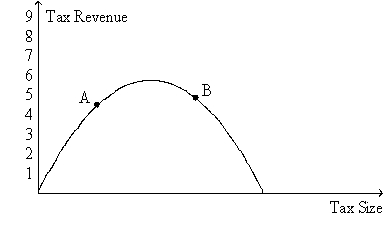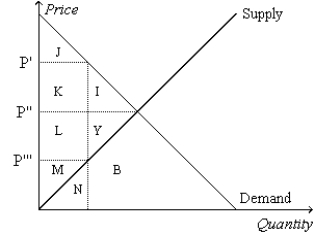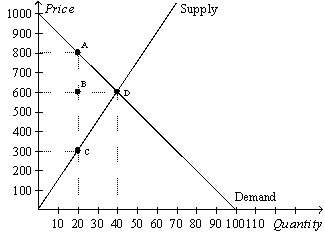A) increase the deadweight loss of the tax and increase tax revenue.
B) increase the deadweight loss of the tax and decrease tax revenue.
C) decrease the deadweight loss of the tax and increase tax revenue.
D) decrease the deadweight loss of the tax and decrease tax revenue.
F) B) and C)
Correct Answer

verified
Correct Answer
verified
Multiple Choice
The deadweight loss from a tax
A) does not vary in amount when the price elasticity of demand changes.
B) does not vary in amount when the amount of the tax per unit changes.
C) is larger,the larger is the amount of the tax per unit.
D) is smaller,the larger is the amount of the tax per unit.
F) B) and D)
Correct Answer

verified
Correct Answer
verified
Multiple Choice
Figure 8-19.The figure represents the relationship between the size of a tax and the tax revenue raised by that tax.  -Refer to Figure 8-19.The curve that is shown on the figure is called the
-Refer to Figure 8-19.The curve that is shown on the figure is called the
A) deadweight-loss curve.
B) tax-incidence curve.
C) Laffer curve.
D) Lorenz curve.
F) C) and D)
Correct Answer

verified
Correct Answer
verified
Multiple Choice
Figure 8-1  -Refer to Figure 8-1.Suppose the government imposes a tax of P' - P'''.The tax revenue is measured by the area
-Refer to Figure 8-1.Suppose the government imposes a tax of P' - P'''.The tax revenue is measured by the area
A) K+L.
B) I+Y.
C) J+K+L+M.
D) I+J+K+L+M+Y.
F) None of the above
Correct Answer

verified
Correct Answer
verified
Multiple Choice
Suppose a tax of $4 per unit is imposed on a good,and the tax causes the equilibrium quantity of the good to decrease from 2,000 units to 1,700 units.The tax decreases consumer surplus by $3,000 and decreases producer surplus by $4,400.The deadweight loss of the tax is
A) $200.
B) $400.
C) $600.
D) $1,200.
F) C) and D)
Correct Answer

verified
Correct Answer
verified
Multiple Choice
Suppose the tax on liquor is increased so that the tax goes from being a "medium" tax to being a "large" tax.As a result,it is likely that
A) tax revenue increases,and the deadweight loss increases.
B) tax revenue increases,and the deadweight loss decreases.
C) tax revenue decreases,and the deadweight loss increases.
D) tax revenue decreases,and the deadweight loss decreases.
F) None of the above
Correct Answer

verified
Correct Answer
verified
Multiple Choice
Figure 8-4
The vertical distance between points A and B represents a tax in the market.  -Refer to Figure 8-4.The amount of the tax on each unit of the good is
-Refer to Figure 8-4.The amount of the tax on each unit of the good is
A) $5.
B) $7.
C) $8.
D) $12.
F) A) and D)
Correct Answer

verified
Correct Answer
verified
Multiple Choice
Ronald Reagan believed that reducing income tax rates would
A) do little,if anything,to encourage hard work.
B) result in large increases in deadweight losses.
C) raise economic well-being and perhaps even tax revenue.
D) lower economic well-being,even though tax revenue could possibly increase.
F) C) and D)
Correct Answer

verified
Correct Answer
verified
True/False
The Social Security tax is a labor tax.
B) False
Correct Answer

verified
Correct Answer
verified
Multiple Choice
Table 8-1
 -Refer to Table 8-1.Suppose the government is considering levying a tax in one or more of the markets described in the table.Which of the markets will allow the government to minimize the deadweight loss(es) from the tax?
-Refer to Table 8-1.Suppose the government is considering levying a tax in one or more of the markets described in the table.Which of the markets will allow the government to minimize the deadweight loss(es) from the tax?
A) market A only
B) markets A and C only
C) markets B and D only
D) market C only
F) A) and C)
Correct Answer

verified
Correct Answer
verified
True/False
Total surplus is always equal to the sum of consumer surplus and producer surplus.
B) False
Correct Answer

verified
Correct Answer
verified
Multiple Choice
Figure 8-1  -Refer to Figure 8-1.Suppose the government imposes a tax of P' - P'''.The consumer surplus after the tax is measured by the area
-Refer to Figure 8-1.Suppose the government imposes a tax of P' - P'''.The consumer surplus after the tax is measured by the area
A) J+K+I.
B) J.
C) M.
D) L+M+Y.
F) All of the above
Correct Answer

verified
Correct Answer
verified
Multiple Choice
Which of the following is a tax on labor?
A) Medicare tax
B) Social Security tax
C) federal income tax
D) All of the above are labor taxes.
F) A) and D)
Correct Answer

verified
Correct Answer
verified
Multiple Choice
When a tax is imposed on the sellers of a good,the
A) demand curve shifts downward by less than the amount of the tax.
B) demand curve shifts downward by the amount of the tax.
C) supply curve shifts upward by less than the amount of the tax.
D) supply curve shifts upward by the amount of the tax.
F) A) and B)
Correct Answer

verified
Correct Answer
verified
True/False
The Laffer curve illustrates how taxes in markets with greater elasticities of demand compare to taxes in markets with smaller elasticities of supply.
B) False
Correct Answer

verified
Correct Answer
verified
Multiple Choice
As the tax on a good increases from $1 per unit to $2 per unit to $3 per unit and so on,the
A) tax revenue increases at first,but it eventually peaks and then decreases.
B) deadweight loss increases at first,but it eventually peaks and then decreases.
C) tax revenue always increases,and the deadweight loss always increases.
D) tax revenue always decreases,and the deadweight loss always increases.
F) All of the above
Correct Answer

verified
Correct Answer
verified
Multiple Choice
Andre walks Julia's dog once a day for $50 per week.Julia values this service at $60 per week,while the opportunity cost of Andre's time is $30 per week.The government places a tax of $35 per week on dog walkers.After the tax,what is the total surplus?
A) $50
B) $30
C) $25
D) $0
F) A) and C)
Correct Answer

verified
Correct Answer
verified
Multiple Choice
A tax levied on the buyers of a good shifts the
A) supply curve upward (or to the left) .
B) supply curve downward (or to the right) .
C) demand curve downward (or to the left) .
D) demand curve upward (or to the right) .
F) All of the above
Correct Answer

verified
Correct Answer
verified
Multiple Choice
Figure 8-9
The vertical distance between points A and C represent a tax in the market.  -Refer to Figure 8-9.The per-unit burden of the tax on sellers is
-Refer to Figure 8-9.The per-unit burden of the tax on sellers is
A) $20.
B) $200.
C) $300.
D) $500.
F) A) and D)
Correct Answer

verified
Correct Answer
verified
Multiple Choice
Taxes on labor have the effect of encouraging
A) workers to work more hours.
B) the elderly to postpone retirement.
C) second earners within a family to take a job.
D) unscrupulous people to take part in the underground economy.
F) A) and B)
Correct Answer

verified
Correct Answer
verified
Showing 241 - 260 of 421
Related Exams